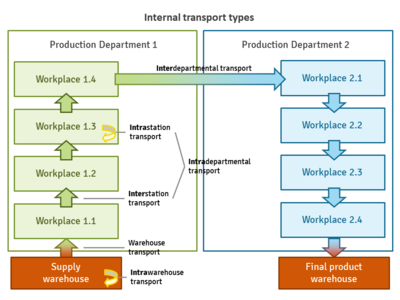Internal transport system
| Internal transport system |
|---|
| See also |
Technical means for handling and internal transport form a very important component of infrastructure of logistics. It actively contribute to the speed of movement of goods at the processes level, efficient handling and transport, at the same time providing a substantial degree of protection against damage and loss of value. Means of internal transport have a very important impact on the course of production processes. There are native means of manipulation and transportation:
- Machinery and transport equipment.
- Storage facilities
- Auxiliary equipment
The main transport devices in modern warehouses are:
- Industrial trucks
- Cranes,
- Conveyors
Special group includes automatic devices, manipulators and industrial robots. Storage devices are of different types:
- Joists
- Buckles
- Supports
- Stands
- Racks
Among the storage racks we can distinguish:
- Sliding shelves - the working movement can be executed in parallel and perpendicular to the plane of load
- Circular shelves,
- Flow racks
- increase the use of warehouse area,
- decrease the carriage of goods within the warehouse,
- ensure the correct flow of goods in the warehouse.
Flow racks with drive set in the technological compact cause the elimination of transport routes. In combination with other cargo handling equipment such as conveyor, control devices allow for the introduction of process automation of storage. Additional equipment in racks, are:
- roller conveyors,
- fixed tiller,
- cranes
Auxiliary devices include:
- devices to facilitate loading of vehicles, such as:
- ramps,
- cargo bridges and countervailing
- movable ramps,
- Auxiliary equipment for storage and handling goods such as:
- palettes
- palletizers,
- pallet collars
- containers,
- yokes.
Each of these groups consists of a plurality of variants, classes and various models depending on the application. The choice of use of a specific system must take into account not only technical parameters, but also the opportunity to work in integrated systems.
Attention should also be paid to the costs, operational performance parameters, connection (synchronization) between partial flow and storage operations. This is a very comprehensive range of organizational and technical knowledge issues, related not only to the design and implementation but also the operation of the transport service systems in manufacturing processes.
References
- Garrido, R., & Allendes, F. (2002). Modeling the internal transport system in a containerport. Transportation Research Record: Journal of the Transportation Research Board, (1782), 84-91.
